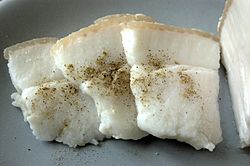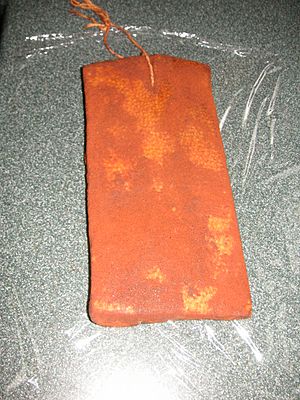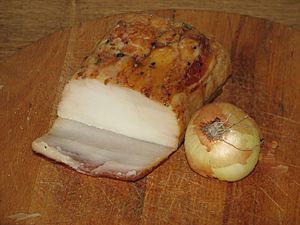Salo (food) facts for kids

Salo, sliced small and sprinkled with black pepper, usually it has a layer of meat
|
|
| Place of origin | Ukraine |
|---|---|

Salo is a traditional food from Slavic countries, especially Ukraine. It is made from cured slabs of fatback, which is the fat from a pig's back. Sometimes, it can also be made from pork belly. Salo usually has little or no lean meat.
People eat salo in many countries, and it has different names. It is often preserved by using dry salt or a salty water mixture called brine. In Eastern Europe, salo is sometimes flavored with paprika or other spices. In Southern Europe, it is often smoked.
The word "salo" is sometimes translated as "bacon" or "lard" in English. However, salo is different from lard because it is not melted down. It is also different from bacon because bacon usually has more meat. Salo is similar to Italian lardo, but lardo is often sliced very thin. Salo from Eastern Europe uses salt, garlic, black pepper, and sometimes coriander for flavor. Lardo often uses rosemary and other herbs.
How Salo Is Made and Stored
To keep salo fresh, it is salted. Sometimes, it is also smoked and stored in a dark, cool place. This way, it can last for a year or even longer.
First, the fat is cut into pieces, usually about 15 by 20 centimeters. Then, layers of fat are placed in a wooden box or barrel. A one-centimeter layer of salt is put on top of each fat layer.
For extra taste and to help it last longer, salo can be covered with a thick layer of paprika. This is common in some areas, and salo with paprika is sometimes called "Hungarian salo." Minced garlic or black pepper can also be added.
If salo is stored for too long or gets too much light, the fat on the surface can go bad. It might turn yellow and taste bitter. When this happens, it is not good to eat. However, spoiled salo can still be useful. It can be used to make leather boots waterproof or as bait for mouse traps. It can also be turned into homemade soap.
Ways to Enjoy Salo
Salo can be eaten in many ways, both raw and cooked. It is often fried or chopped very finely with garlic. This mixture can be used as a topping for borscht, which is a beet soup. Small pieces of salo are also added to some types of sausage.
A popular snack is thinly sliced salo on rye bread rubbed with garlic. This is a favorite in Ukraine and Russia.
Salo is also often chopped into small pieces and fried. This process melts the fat, which can then be used for cooking. The crispy bits that are left after frying are called cracklings. In Ukrainian, they are called shkvarky. These cracklings are used to flavor fried potatoes or varenyky. They can also be spread on bread as a snack.
The thick pork skin that is left after the fat has been used is sometimes boiled to make soup stock. If the skin is soft enough after boiling, it can be chopped or ground with salo, herbs, and spices. This mixture can then be spread on bread.
Salo and Chocolate
There is a funny saying, "chocolate-coated salo." This comes from a joke about Ukrainians. It is now a common phrase among people in Eastern Europe. It means a strange mix of tastes or desires, like bacon ice cream.
In the 2000s, a candy factory in Odesa started making candies called Salo v Shokoladi. These chocolate candies were first made as an April Fools' Day joke. They do not actually contain real salo. Instead, they have a regular caramel filling with a small amount of melted fat added for a salty flavor.
See Also
 In Spanish: Salo (alimento) para niños
In Spanish: Salo (alimento) para niños


